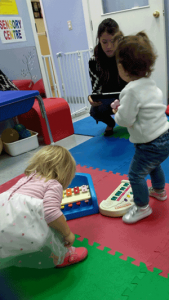
SPO Highlight: Newcomer Centre of Peel CNC Program
The staff at Newcomer Centre of Peel have a commitment to meet the individual needs of the child. This is not easy, as the program has over 100 children with 15-16 per class. Given these large numbers, caregivers were having trouble finding time to record observations. If they tried to jot down an observation as it happened, it took attention away from the group. When they waited until the end of the day, they struggled to remember what took place. They tried different observation techniques, including notepaper on a wall and a shared camera. None of these worked well. This frustrating situation is faced by many programs.
CNC program manager Jana Jakimovska and her childcare team brainstormed a better way to observe and document. They came up with the solution to use tablets. The team felt that it would simplify recording observations throughout the day. And, they could review the recordings when they met to plan for each child.
Technology is expensive, so they made sacrifices and limited expenses in other areas. It took time, but they used these savings to buy a tablet for each room.
The benefits were immediate. The children love having their pictures taken. For caregivers, they can quickly record the observations throughout the day. When the program ends or during naptime, CNC staff go through the videos and identify important moments. Plus, the tablets also promote more detailed observations.
“Through video you don’t have to just follow just one child,” says Jakimovska. “You can see something you might have missed during the day.”
Using the tablet, staff make connections between what they have seen, children’s developmental levels, and overall programming. They use OneNote and cross-reference observations with ELECT and the Nippissing development screening. Caregivers adapt both these tools for CNC children. They also develop program plans on the tablets. This allows them to program around any areas of interest and/or struggle. And, it reduces paperwork.
Another helpful piece of technology are the surveillance cameras in each classroom. Recordings go back up to two months, so the program can get a clear picture of child’s progress and teacher efforts.
All children have a personal profile, which travels with them as they move from class to class. This gives staff the opportunity to observe the stages of development. In turn, through video footage, parents can see how their child interacts and develops over time. Caregivers even show techniques they use to support the children in class. Then, parents can try these methods at home.
“There can be a huge difference between how children behave at home versus in the classroom,” explains Jakimovska. “For example, in the class they may follow instructions and be so mature, but with their parents everything is upside down. The videos provide a good way to show that children have the capacity to do things.”
Newcomer Centre of Peel recognizes that nothing can replace caregiver knowledge, experience and engagement. That said, technology in the program does support their focus on observations.







